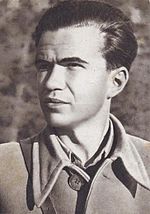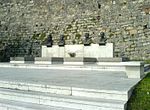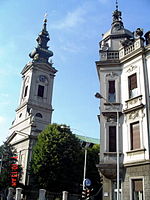Keys Handover Memorial
1967 establishments in Serbia1967 sculptures19th century in BelgradeBuildings and structures completed in 1967Cultural heritage of Serbia stubs ... and 6 more
Culture in BelgradeMonuments and memorials in BelgradeMonuments and memorials in SerbiaProtected Historic LandmarksSerbia stubsStari Grad, Belgrade

The Keys Handover Memorial (English: Место предаје кључева 1867. године, English: Place where keys were handed over in 1867) in Belgrade, Serbia, marks the spot where on 6 April 1867, the town keys of the several Serbian fortresses were given to Prince Mihailo Obrenović by the Ottoman Turks. That moment was an important step towards Serbian international recognition at the Treaty of Berlin in 1878. The memorial was declared a Protected Historic Landmark in 1991, and it is protected by Republic of Serbia.
Excerpt from the Wikipedia article Keys Handover Memorial (License: CC BY-SA 3.0, Authors, Images).Keys Handover Memorial
Ушће, Belgrade New Belgrade
Geographical coordinates (GPS) Address Nearby Places Show on map
Geographical coordinates (GPS)
| Latitude | Longitude |
|---|---|
| N 44.82 ° | E 20.45 ° |
Address
Гондола
Ушће
11000 Belgrade, New Belgrade
Central Serbia, Serbia
Open on Google Maps










